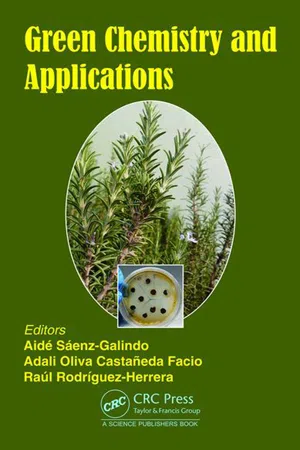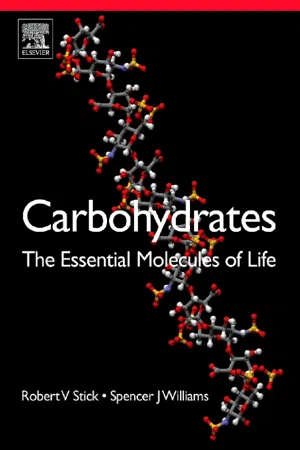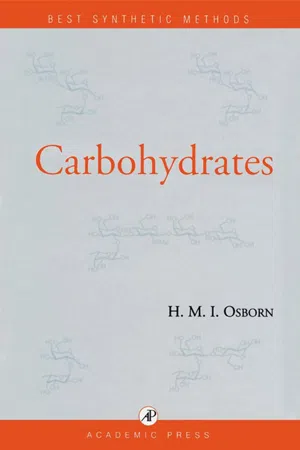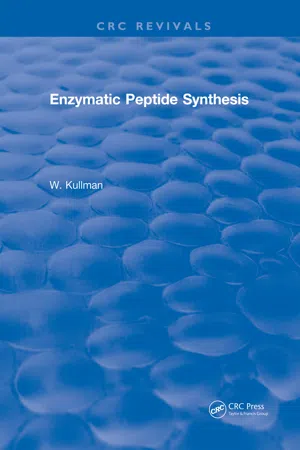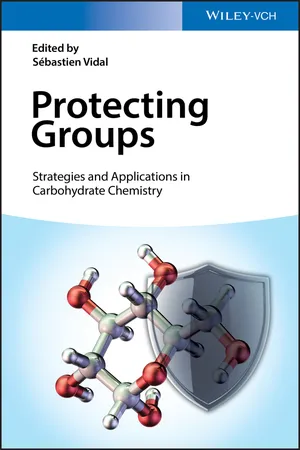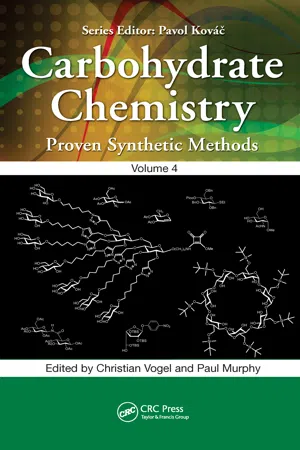Chemistry
Protecting Groups
Protecting groups are chemical functional groups that are temporarily added to a molecule to protect a reactive functional group from unwanted reactions during a chemical reaction. They are commonly used in organic synthesis to selectively modify a specific functional group without affecting other parts of the molecule. Protecting groups can be removed after the desired reaction has taken place.
Written by Perlego with AI-assistance
Related key terms
Related key terms
1 of 4
Related key terms
1 of 3
7 Key excerpts on "Protecting Groups"
- eBook - ePub
- Aide Sáenz-Galindo, Adali Facio, Raul Rodriguez-Herrera, Aide Sáenz-Galindo, Adali Oliva Castañeda Facio, Raul Rodriguez-Herrera(Authors)
- 2020(Publication Date)
- CRC Press(Publisher)
The synthesis starts by assembling the molecular skeleton (not shown), with carbon-carbon double and triple bonds as profunctionality (Hu and Brown, 2005). This is followed by the generation tetrahydrofuran rings and alcohol functions through a series of functionalization reactions. The final stage of the synthesis involves a series of transition-metal-catalyzed processes, for the completion of the molecular skeleton, resulting in an overall avoidance of the protecting group. This undoubtfully suggests the fact that the variation in the order of introduction of functional groups can drastically minimize or even completely avoid the use of Protecting Groups in an organic synthesis. Thus this concept of designing the order of introduction of a functional group by first assembling the molecular skeleton in a reaction will indeed open up the realization of protecting group free synthesis (Fraunhoffer et al., 2005; Yoshimitsu et al., 1997; McFadden and Stoltz, 2006; Ding et al., 2006).Conclusion
The percentage atom utilization in a chemical reaction is a critical factor that characterizes the greenness of the reaction. Minimizing the use of derivatives in a chemical synthesis can be achieved by avoiding the use of Protecting Groups which will result in an increase of atom economy on the reaction. Avoiding the use of Protecting Groups increases the atom economy of the synthesis. Enzyme catalysis, sequential introduction of functional groups and biomimicking approaches can help achieve this goal to a great extent. But one may have to be resigned to the fact that complete removal of Protecting Groups from a synthetic scheme, though ideal may not be feasible in all cases. Alternate approaches like non-covalent and photolabile protection/deprotection groups can be relied on to improve the greenness of a synthetic process. Functionalization to improve selectivity can be used to avoid additional deprotection steps and can further increase the eco-friendliness of a synthetic route. Careful choice of starting materials and well-designed sequential introduction of functional groups can significantly reduce dependency of a synthetic scheme on Protecting Groups. It may be worth noting that other aspects of a modification or derivatization step might determine the overall effectiveness of the synthetic route and indirectly contribute to a greener process. - Wenyi Zhao(Author)
- 2023(Publication Date)
- CRC Press(Publisher)
13 Protecting Groups
DOI: 10.1201/9781003288411-13Protection and deprotection of functional groups have been playing a great role in organic synthesis. Protections fall predominately into three categories: protection of amino groups, protection of carboxylic acids as esters, and protection of hydroxyl groups. The most common protecting group1for the amino group is tert-butyloxycarbonyl (Boc), followed by benzyl and carbobenzyloxy (Cbz) groups (these two groups can be removed by catalytic hydrogenolysis). Frequently, carboxylic acids are protected as their corresponding alkyl esters, such as methyl ester or ethyl ester. A wide variety of Protecting Groups are used for the protection of the hydroxyl group. The most common Protecting Groups are benzyl, silicon-containing groups, and acetyl and benzoyl groups. In general, the benzyl-protecting group works well and tolerates acidic or basic conditions. There are concerns, however, regarding product contamination over the use of palladium-catalyzed deprotection of Protecting Groups, especially at the late stage in the synthesis. Both acetyl and benzoyl groups proved to be labile under basic conditions and extensive protecting group migration was observed.13.1 PROTECTION OF HYDROXYL GROUP
13.1.1 Prevention of Side Reactions
13.1.1.1 Friedel–Crafts Alkylation
Selection of the right protecting group is critical for the success of a reaction. For example, attempts to make indeno-β-lactam 2a under Friedel–Crafts alkylation conditions by treatment of benzyl-protected phenol 1a with TfOH failed, giving, instead of 2a, chroman 3 in 44% yield (Equation 13.1).2(13.1)To circumvent the undesired cyclization, a bulky triisopropylsilyl (TIPS) group was used to reduce the nucleophilicity of the oxygen atom. The reaction was conducted in dichloromethane in the presence of Sc(OTf)3 and 2,6-di-tert-butylpyridine (DTBP) affording the desired indeno-β-lactam 2b- eBook - ePub
- Robert V. Stick, Spencer Williams(Authors)
- 2010(Publication Date)
- Elsevier Science(Publisher)
1–6 ]Much of today’s chemistry is concerned with synthesis, and carbohydrate chemistry is no exception. The large pharmaceutical companies (‘Big Pharma’) once employed small armies of chemists to synthesize a myriad of compounds that were necessary for lead development of a potential ‘block buster’ drug. Nowadays, however, the same companies ‘outsource’ much of their synthetic work to smaller, private companies, but there is still a (growing) need for synthetic chemists to do the work. If you want to do synthesis, you need to know about Protecting Groups.The Protecting Groups used in carbohydrates are generally the same as those of mainstream organic chemistry; the difference, however, is that even a monosaccharide presents a myriad of hydroxyl groups that need protection, in either an individual (regioselective) or a unique (orthogonal) manner. Also, the introduced Protecting Groups may affect the reactivity of the resulting molecule or even participate in some of its reactions.Synthesis with carbohydrates would be a less complicated matter if it were confined to the natural and abundant aldoses, ketoses and oligosaccharides. However, there often arises the need for modified monosaccharides or, perhaps, an unusual or rare oligosaccharide. For example, how would one approach the synthesis of a molecule such as ‘3-deoxy-d-glucose’[a ]starting from d-glucose?a As ‘3-deoxy-d-allose’ is just as good, an unambiguous name should be used: 3-deoxy-d-ribo-hexose. The molecule is depicted as an α/β mixture of pyranose forms.The problems are twofold: first, the need for a chemical reaction that will replace a hydroxyl group by a hydrogen atom; second, the need to carry out this replacement only - eBook - ePub
- Helen Osborn(Author)
- 2003(Publication Date)
- Academic Press(Publisher)
2 Selective Hydroxyl Protection and Deprotection Jeremy Robertson, Petra M. Stafford Dyson Perrins Laboratory, South Parks Road, Oxford OX1 3QY, UK 2.1 INTRODUCTION In an ideal world it would be possible to effect any desired glycosylation between two free sugars with total control of regio- and stereochemistry to produce a single oligosaccharide. Although enzymes can be sufficiently selective to catalyse such transformations, a general chemical solution to this problem is yet to be found. Aside from the problem of controlling the stereochemistry at the newly formed glycosidic linkage, it is simply not possible to select unambiguously, and at will, which hydroxyl group participates in glycosylation and complex mixtures often result. As in other areas of organic synthesis, ensuring that a particular functional group undergoes reaction without interference from others can be achieved by blocking those others with Protecting Groups. The general principles of protecting group chemistry and the multitude of methods for their introduction and removal have been summarised in a number of excellent books [ 1 ] and review articles [ 2 ] but carbohydrates present particular problems as they possess a number of nucleophilic and mildly acidic hydroxyl groups arranged on relatively short carbon chains, and the density of functionality is accordingly high [ 3 ]. In general, the various hydroxyl groups cannot be considered in isolation; their reactivity influences, and is influenced by, neighbouring functionality and any modifications made to one of them often leads to changes in the relative reactivity of the others. Because of these subtleties, carbohydrate chemistry may appear to have a large associated ‘lore’ which can seem unnecessarily arcane to the uninitiated; this has led, in the past, to a separation of carbohydrate chemistry from what was regarded as mainstream organic synthesis - eBook - ePub
- W. Kullman(Author)
- 2018(Publication Date)
- CRC Press(Publisher)
Chapter 12Proteases as Catalysts in Protecting Group Chemistry
I. Introduction
The use of proteases in synthetic peptide chemistry is not confined solely to the basic step of peptide bond formation. In addition, proteases have also been described as useful and efficient agents for the introduction and removal of Protecting Groups. This area of synthetic methodology is by no means marginal in interest; indeed as noted previously (cf. Chapter 6 , Section I.B and Chapter 8 , Section II ), a judicious protecting group strategy is indispensable for a successful peptide synthesis. Consequently, a major part of peptide synthetic chemistry has been concerned with the development of suitable Protecting Groups,1 , 2 which are commonly subdivided into two categories: semipermanent and temporary blocking groups. To recap briefly, the so-called semipermanent protector groups have to survive the multiple reaction steps occurring during the progress of synthesis and their final removal usually represents the last step of the synthetic pathway, i.e., the release of the free target peptides. In contrast, temporary protector groups must be removed prior to each elongation step of the growing peptide chain. Criteria for appropriate semipermanent blocking groups are readily categorized as follows: convenient introduction, inertness to the conditions prevailing during synthetic manipulations, and reversibility without affecting the integrity of the final product. Satisfactory temporary Protecting Groups must be selectively removable under mild conditions without injuring semipermanent blocking groups or, as a matter of course, the peptidic backbone. The traditional procedure of unidirectional, stepwise incorporation of single amino acid derivatives involves the removal of the Nα -protecting group prior to each elongation cycle. In cases where the synthetic strategy involves fragment coupling as well, the α-carboxyl protection has also to be a selectively removable in the presence of semipermanent and temporary Nα - Sebastien Vidal, Sebastien Vidal(Authors)
- 2018(Publication Date)
- Wiley-VCH(Publisher)
1 Protecting Group Strategies in Carbohydrate Chemistry Anne G. Volbeda Gijs A. van der Marel and Jeroen D. C. Codée Leiden Institute of Chemistry, Leiden University, Einsteinweg 55, 2333 CC, Leiden, The Netherlands Carbohydrates are the most densely functionalized class of biopolymers in nature. Every monosaccharide features multiple contiguous stereocenters and bears multiple hydroxyl functionalities. These can, in turn, be decorated with sulfate groups, acyl esters, lactic acid esters and ethers, or phosphate moieties. Amine and carboxylate functions can also be present. Most often, the amine groups are acetylated, but different amide functions are also found, as well as N‐sulfates and alkylated amines. The discrimination of the functional groups on a carbohydrate ring has been and continues to be one of the great challenges in synthetic carbohydrate chemistry [ 1 – 3 ]. This chapter describes the differences in the reactivity of the various functional groups on a carbohydrate ring and how to exploit these in the design of effective protecting group strategies. The Protecting Groups on a carbohydrate dictate the reactivity of the (mono)saccharide, and this chapter will describe how protecting group effects can be used to control stereoselective transformations (most importantly, glycosylation reactions) and reactivity‐controlled one‐pot synthesis strategies. Applications and strategies in automated synthesis are also highlighted. 1.1 Discriminating Different Functionalities on a Carbohydrate Ring The main challenge in the functionalization of a carbohydrate (mono)saccharide is the discrimination of the different hydroxyl functionalities. The – often subtle – differences in reactivity can be capitalized upon to formulate effective protecting group strategies (see Scheme 1.1 A). The primary alcohol functionality is generally the most reactive of the hydroxyl groups because of steric reasons (see Chapter 2)- eBook - ePub
Carbohydrate Chemistry
Proven Synthetic Methods, Volume 4
- Christian Vogel, Paul Murphy, Christian Vogel, Paul Murphy(Authors)
- 2017(Publication Date)
- CRC Press(Publisher)
O -acyl group, making direct synthesis of β-thiols with nonparticipating groups in the 2-position quite difficult. Therefore, protecting group manipulation is a common requirement, which makes efficient protecting group strategies for anomeric thiols vital.There have been relatively few instances of widely applicable Protecting Groups for sulfur in carbohydrate chemistry. The most common S -protecting group in carbohydrate chemistry by far is the thioacetate, with examples of its use in the synthesis of a wide range of glycoconjugates, including glycoporphyrins,12 glycosylsulfonamides,13 and precursors of C -glycosyl derivatives.14 However, this is not a viable option in situations such as that described above, because selective O-deacetylation cannot be carried out in the presence of thioacetates using conventional methods. There are some instances of disulfides being employed for this purpose, e.g., the use of unsymmetrical tert -butyl disulfides to temporarily protect an anomeric sulfur in trichloroacetimidate-mediated glycosylation reactions.15 This protection strategy has also been applied to the synthesis of an S -linked octasialic acid wherein the glycosidic bonds were formed by SN 2 displacement of a 9-iodo residue.16 The triisopropylsilyl group has been employed to protect anomeric thiols,17 but the frequency with which O -silyl ethers are also used makes this a very rare choice. It should also be noted that the introduction of a silyl substituent has been employed to enhance the nucleophilicity of sulphur for reaction with a variety of electrophiles.18 Alkyl thioethers are widely documented as temporary Protecting Groups for thiols outside of carbohydrate chemistry, but their removal often requires harsh conditions and/or highly toxic reagents,19 making selective deprotection of sulfur quite difficult. Although trityl ethers are associated with quite mild deprotection conditions when masking hydroxyl groups, generation of free thiols by hydrolysis of triphenylmethylthioethers has traditionally required phenylmercury (II) acetate.20 However, in recent years far milder conditions have been developed utilising triisopropylsilane in the presence of trifluoroacetic acid21 in a similar manner to methods recently applied to removal of the S -xanthenyl protecting group.22
Index pages curate the most relevant extracts from our library of academic textbooks. They’ve been created using an in-house natural language model (NLM), each adding context and meaning to key research topics.
Explore more topic indexes
Explore more topic indexes
1 of 6
Explore more topic indexes
1 of 4
